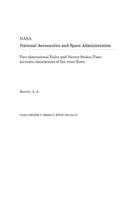
Two-Dimensional Euler and Navier-Stokes Time Accurate Simulations of Fan Rotor Flows
Series:
Two numerical methods are presented which describe the unsteady flow field in the blade-to-blade plane of an axial fan rotor. These methods solve the compressible, time-dependent, Euler and the compressible, turbulent, time-dependent, Navier-Stokes conservation equations for mass, momentum, and energy. The Navier-Stokes equations are written in Favre-averaged form and are closed with an approximat
NaN
VOLUME
English
Paperback

Two numerical methods are presented which describe the unsteady flow field in the blade-to-blade plane of an axial fan rotor. These methods solve the compressible, time-dependent, Euler and the compressible, turbulent, time-dependent, Navier-Stokes conservation equations for mass, momentum, and energy. The Navier-Stokes equations are written in Favre-averaged form and are closed with an approximate two-equation turbulence model with low Reynolds number and compressibility effects included. The unsteady aerodynamic component is obtained by superposing inflow or outflow unsteadiness to the steady conditions through time-dependent boundary conditions. The integration in space is performed by using a finite volume scheme, and the integration in time is performed by using k-stage Runge-Kutta schemes, k = 2,5. The numerical integration algorithm allows the reduction of the computational cost of an unsteady simulation involving high frequency disturbances in both CPU time and memory requirements. Less than 200 sec of CPU time are required to advance the Euler equations in a computational grid made up of about 2000 grid during 10,000 time steps on a CRAY Y-MP computer, with a required memory of less than 0.3 megawords. Boretti, A. A. Glenn Research Center NASA ORDER C-99066-G; RTOP 505-62-21...
Price Comparison [India]
In This Series
Bestseller Manga
Trending NEWS




















